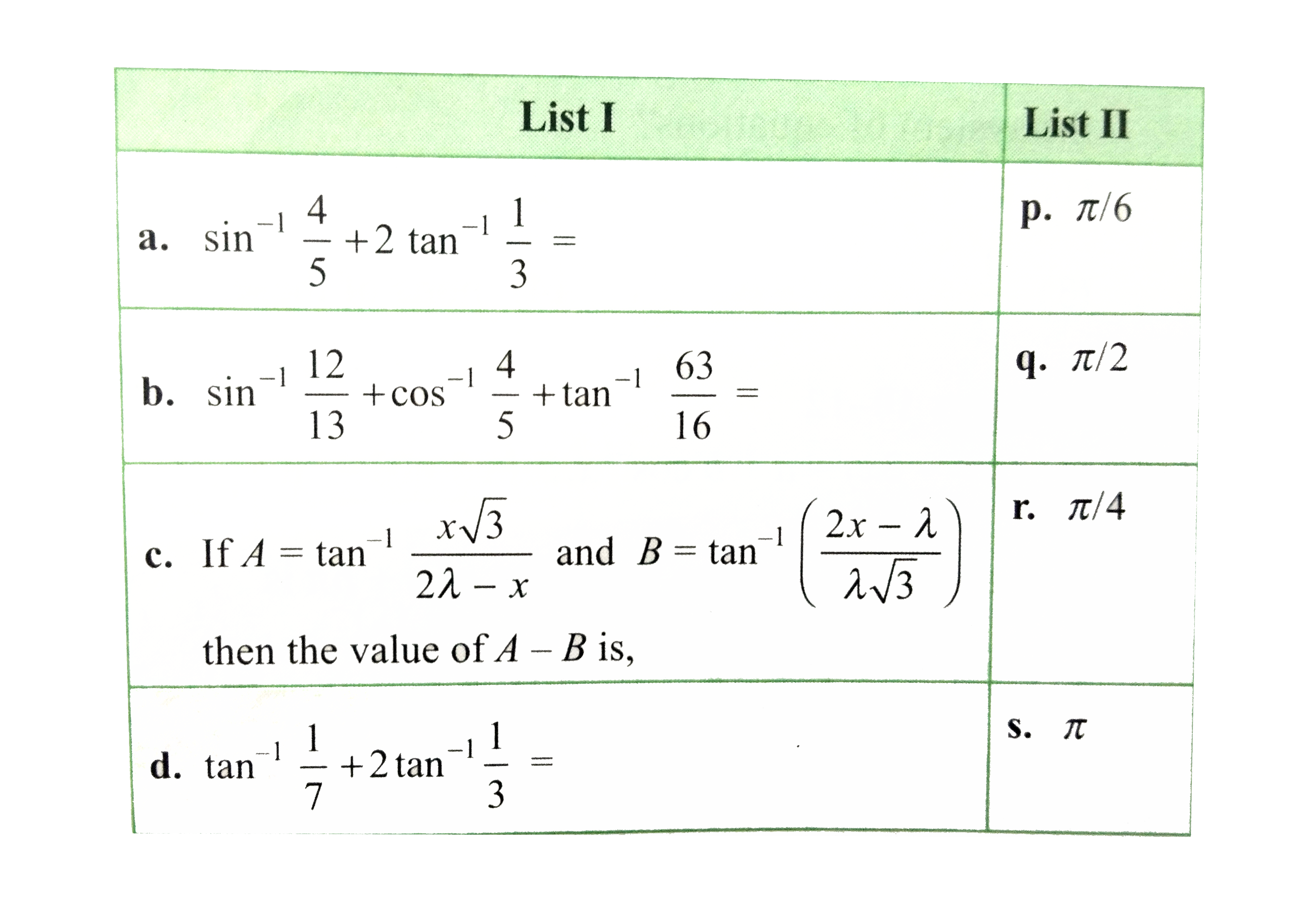Match the following List I to List II

The correct Answer is:
(a)
and
(b)
(c)
Now,
(d)
Topper's Solved these Questions
- BOOK - CENGAGE ENGLISHCHAPTER - INVERSE TRIGONOMETRIC FUNCTIONSEXERCISE - Numerical value type18videos
INVERSE TRIGONOMETRIC FUNCTIONS
- BOOK - CENGAGE ENGLISHCHAPTER - INVERSE TRIGONOMETRIC FUNCTIONSEXERCISE - Archives (JEE MAIN)2videos
INVERSE TRIGONOMETRIC FUNCTIONS
- BOOK - CENGAGE ENGLISHCHAPTER - INVERSE TRIGONOMETRIC FUNCTIONSEXERCISE - Linked comprehension type16videos
INVERSE TRIGONOMETRIC FUNCTIONS
- BOOK - CENGAGE ENGLISHCHAPTER - INTRODUCTION TO VECTORS EXERCISE - MATRIX-MATCH TYPE3videos
INTRODUCTION TO VECTORS
- BOOK - CENGAGE ENGLISHCHAPTER - JEE 2019EXERCISE - Chapter 109videos
JEE 2019
Similar Questions
Let a function f(x)=[x]{x}−|x| where [.],{.} are greatest integer and fractional part respectively then match the following List-I with List-II.

 View Solution
View SolutionMatch the following in List-I with List II and select the corect option :-
List−IList−IIaKP=QiAlways nonspontaneousbT>ΔH/ΔSiiIsothrmal processcΔH=+veΔS=−veiiiEquilibriumdq=−veivspontaneous and endothermicView SolutionMatch the following
List -I List - II A) False fruit I) BananaB) Pathenocarpic fruit II) Jack fruitC) Aggregate fruit III) Annona(D) Composite fruit IV) Pea V) AppleView SolutionMatch the following
{:("List - I", "List - II"),("(A) Taeniophyllum","(I) Epiphyte"),("(B) Ground nut","(II) Mangrove plant"),("(C) Vanda","(III) Photosynthetic "),(," roots"),("(D) Rhizophora","(IV) Nodular roots"),(,"(V) Stilt roots"):}View SolutionMatch the following
List - IList - IIA) TrichomesI) CambiumB) Root hairsII) LeavesC) MesophyllIII) UnicellularD) DicotyledonousIV) Epidermal hairs stemView SolutionMatch the following.
List-IList-III) Tight junctionsA) Cement neighbouring cellsII) Gap junctionsB) Stop leakage of substancesIII) Adhering junctionsC) rapid transfer of ionsIV) EpitheliaD) Upon growingView SolutionMatch the following
List - IList - II1) EpidermisI) Bean shaped cells2) CuticleII) Stomatal aperture, guard cells and subsidiary cells3) Stomatal apparatusIII) Thick waxy layer4) Guard cellsIV) Outermost layerView SolutionMatch the following.
List-IList-III) Glands without ductsA) Cerimunous glandII) Isolated unicellular glandsB) Islets of langerhansIII) Glands with ductsC) Goblet cellsIV) Glands that produce waxD) Salivary glandsView SolutionMatch the following
List - I List - IIA) Rachis1) Vascular tissues B) China roseII)Peduncle growth islimitedC) VeinsIII) Alternate phyllotaxyD) Cymose IV)Pinnately compound inflorescence leafView SolutionMatch the following
Match list I (Type of ore) with list II.
 View Solution
View Solution

